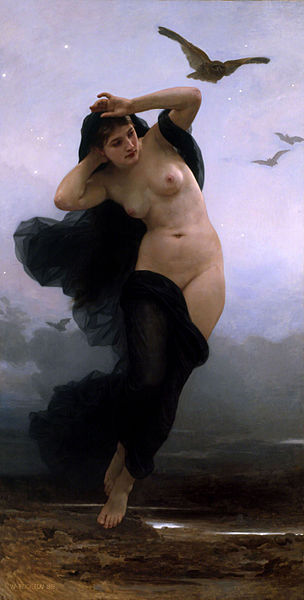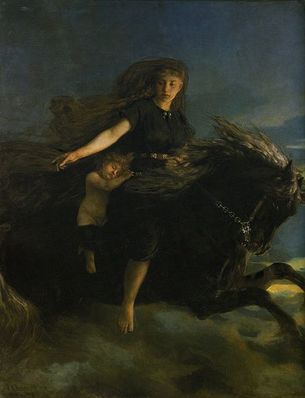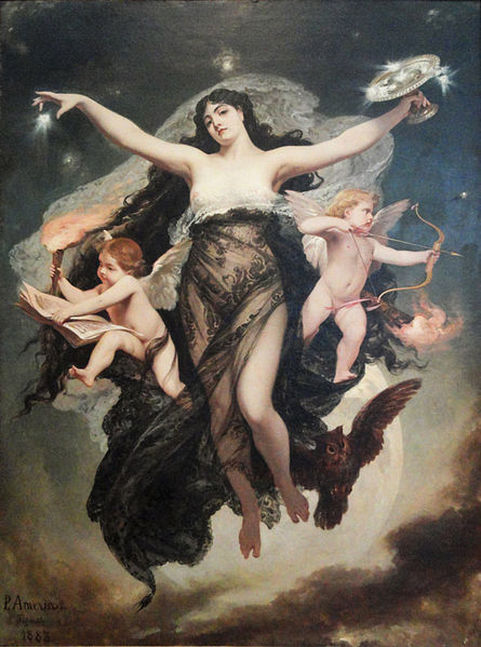THE GODDESS NYX IN GREEK MYTHOLOGY by Greek Legends and Myths
Posted by ANNA KIM

NYX(NOX) GODDESS OF THE NIGHT
The pantheon of Ancient Greece contained hundreds of deities, and whilst today, the most famous of these deities are those based upon Mount Olympus, there was a whole plethora of deities who preceded the likes of Zeus and Poseidon.
One of these earlier deities was the goddess Nyx, a “dark” goddess, one associated with night, and one a powerful one at that.
One of these earlier deities was the goddess Nyx, a “dark” goddess, one associated with night, and one a powerful one at that.
THE PROTOGENOI NYX
Nyx, according to Hesiod’s Theogony, was one of the Protogneoi, the primordial first born gods of the Greek cosmos. To this end, Nyx was considered to be the daughter of the goddess Chaos, the very first of all deities. Nyx would effectively become the goddess of Night, and was depicted a beautiful woman, dressed in black, surrounded by mist, and often in the company of some of her numerous children. In the most common timeline of Greek mythology, Nyx was partnered with Erebus (darkness), and would produce to children also named as Protogenoi, Aether and Hemera. Conversely, Aether and Hemera as Light and Day, were the opposite of their parents, Night and Darkness. |
NYX IN THE UNDERWORLD
Nyx would reside in the depths of Tartarus, the dark recesses of the Underworld, and the dark misty air which swirled around Tartarus was said to be Erebus. Many of the other dark deities of Ancient Greece would also reside there.
Each night Nyx would emerge from her cave within Tartarus, and hand in hand with Erebus, would block out the light emitted from Aether, bringing night and darkness to the world.
The next morning Hemera would then emerge from Tartarus, and sweep away the darkness of night, and Nyx would return to her abode. Thus mother and daughter were never in the same place at the same time.
In later Greek mythology, the likes of Eos (Dawn), Helios (Sun) and Apollo would replace the roles of Aether and Hemera, but Nyx herself was never subjugated; an indication of the esteem which the powerful Nyx was held in.
Each night Nyx would emerge from her cave within Tartarus, and hand in hand with Erebus, would block out the light emitted from Aether, bringing night and darkness to the world.
The next morning Hemera would then emerge from Tartarus, and sweep away the darkness of night, and Nyx would return to her abode. Thus mother and daughter were never in the same place at the same time.
In later Greek mythology, the likes of Eos (Dawn), Helios (Sun) and Apollo would replace the roles of Aether and Hemera, but Nyx herself was never subjugated; an indication of the esteem which the powerful Nyx was held in.
NYX AND ZEUSNyx was never really the central figure in surviving mythological tales, but the goddess does appear in one tale of Hera and Hypnos, Hypnos (Sleep) being another child of Nyx. Hera convinced Hypnos to put her husband, Zeus, to sleep whilst she plotted against him. Hypnos was not powerful enough though to completely incapacitate Zeus, and when he found out what Hypnos had done, Zeus chased after him. Hypnos sought refuge in his mother’s cave, and on finding out the location of his prey, gave up the chase, Zeus wary of angering Nyx. |
OTHER CHILDREN OF NYX
Aether and Hemera (and Hypnos) were not the only children of Nyx, for Hesiod would mention a whole series of further deities, many of which were dark in nature. The named children of Nyx included, Thanatos (Death) the twin brother of Hypnos, Eris (Strife), Geras (Old Age), Moros (Doom), Nemesis (Retribution), and also groups of deities, the Moirai (Fates), the Keres (the Hounds of Hades), and the Oneiroi (the gods of dreams).







